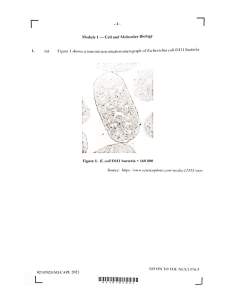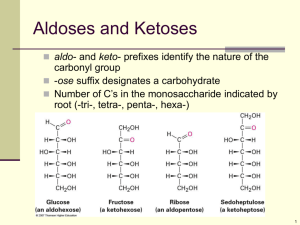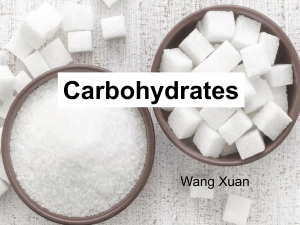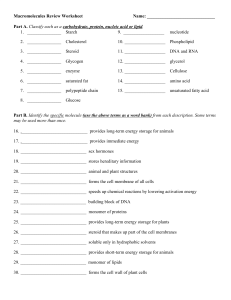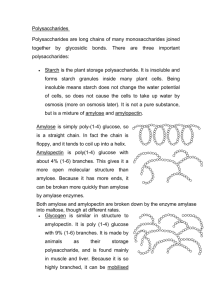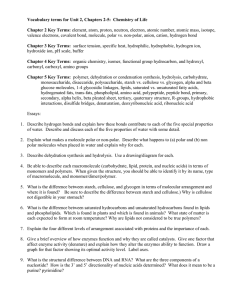Uploaded by
Shadman Shafin
Polysaccharides: Structure and Function - Starch, Glycogen, Cellulose
advertisement
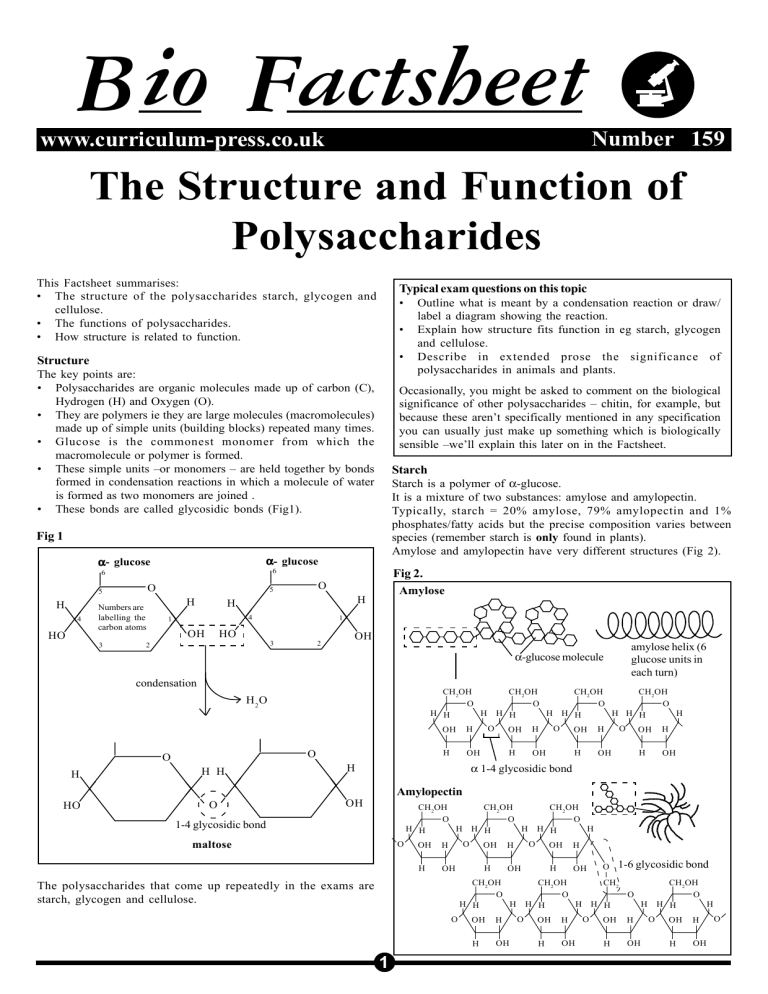
B io Factsheet www.curriculum-press.co.uk Number 159 The Structure and Function of Polysaccharides This Factsheet summarises: • The structure of the polysaccharides starch, glycogen and cellulose. • The functions of polysaccharides. • How structure is related to function. Typical exam questions on this topic • • • Structure The key points are: • Polysaccharides are organic molecules made up of carbon (C), Hydrogen (H) and Oxygen (O). • They are polymers ie they are large molecules (macromolecules) made up of simple units (building blocks) repeated many times. • Glucose is the commonest monomer from which the macromolecule or polymer is formed. • These simple units –or monomers – are held together by bonds formed in condensation reactions in which a molecule of water is formed as two monomers are joined . • These bonds are called glycosidic bonds (Fig1). Occasionally, you might be asked to comment on the biological significance of other polysaccharides – chitin, for example, but because these aren’t specifically mentioned in any specification you can usually just make up something which is biologically sensible –we’ll explain this later on in the Factsheet. Starch Starch is a polymer of α-glucose. It is a mixture of two substances: amylose and amylopectin. Typically, starch = 20% amylose, 79% amylopectin and 1% phosphates/fatty acids but the precise composition varies between species (remember starch is only found in plants). Amylose and amylopectin have very different structures (Fig 2). Fig 1 α- glucose α- glucose 6 6 O 5 H 4 Numbers are labelling the carbon atoms 4 1 HO OH Amylose H H 1 HO 3 Fig 2. O 5 H 3 2 Outline what is meant by a condensation reaction or draw/ label a diagram showing the reaction. Explain how structure fits function in eg starch, glycogen and cellulose. Describe in extended prose the significance of polysaccharides in animals and plants. 2 OH α-glucose molecule amylose helix (6 glucose units in each turn) condensation CH 2OH CH 2OH CH2OH CH 2OH O O O O H H H H H H H H H H H H OH OH OH OH O O O H H H H H2O H O O H H H H HO O OH H OH H OH OH H OH α 1-4 glycosidic bond Amylopectin CH 2OH CH 2OH CH 2OH O O O H H H H H H H H H OH OH OH O O O H H H 1-4 glycosidic bond maltose H H OH H OH OH O 1-6 glycosidic bond CH2OH CH2OH CH2 CH 2OH O O O O H H H H H H H H H H H H OH OH OH OH O O O O O H H H H The polysaccharides that come up repeatedly in the exams are starch, glycogen and cellulose. H 1 OH H OH H OH H OH Bio Factsheet 159 The Structure and Function of Polysaccharides www.curriculum-press.co.uk Significance? More branches and shorter chains = more “ends” = faster to breakdown when energy is needed. Whereas starch is the storage molecule in plants, glycogen is the store in animals, fungi and bacteria that may suddenly need to release their stores. Amylose Alpha-glucose molecules form an unbranched chain that coils itself into a helix (like a spring). Significance of this? The helix is compact, making it a good storage molecule. The glucose molecules are joined by 1-4 linkages (meaning that carbon atom 1 of one glucose molecule links with carbon atom 4 of the next glucose molecule). In humans, glycogen is stored mainly in the liver and muscles and is important in helping to regulate blood glucose levels. Cellulose (Fig 4) Amylopectin Alpha-glucose molecules form long, branched chains. Significance? Long chains means few “ends” making amylopectin difficult to break down = good for storage. The glucose molecules within the branches are 1-4 links (as in amylose) but where the branch joins the main chain, a 1-6 link forms. H CH2OH CH 2OH OH O H O OH H O H OH O H H H O OH O H H H H H H H O H The mixture of amylose and amylopectin is built up into large starch grains in potato tubers, many seeds and the stroma of chloroplasts, where they act as energy stores. • H CH 2OH OH β 1-4 glycosidic bonds polymer Parallel polysaccharide chains Exam questions don’t usually ask you explicitly about the way in which the structure of amylose and amylopectin fit their function, rather they usually expect you to mention these details when asked about starch as a whole. So remember: • • • OH H CH2OH CH2OH OH O H starch is compact = good for storage. insoluble = osmotically inactive. too big to pass through membranes = inactive/good for storage. provides many glucose molecules = good respiratory substrate. O OH H O H OH O H H H O OH O H H H H H H H O H O H CH 2OH H O H hydrogen bonds H CH2O CH 2O OH O Exam Hints Many candidates mistakenly appear to believe that: 1. Long chains of starch provide support. They had clearly confused the roles of starch and cellulose. 2. Starch stores something else – inside its helix. 3. Starch is soluble. 4. Cell walls are made of starch. H O O OH H OH O H H H H H H H O H OH O H H H O H OH CH 2OH H OH Polymer of beta glucose arranged in long, straight chains. Whereas starch and glycogen are storage molecules, cellulose is a structural polysaccharide. Cellulose is mechanically strong because: (i) the inverted arrangement of successive glucose molecules means that thousands of hydrogen bonds form. (ii) cellulose molecules are tightly cross-linked to form microfibrils (iii) the microfibrils form fibres. Glycogen α- glucose polymer. Branched like amylopectin but has shorter 1,4 chains and many more branches (Fig 3). Fig 3. Glycogen α-glucose Within plant cell walls the fibres are arranged in layers running across each other, are interwoven and these layers are held or “glued” together by a matrix of other substances. 1-6-glycosidic link Significance? Cellulose cell walls need to be strong to maintain turgidity so that leaves are held in a position to absorb maximum sunlight. Stems remain flexible but firm in winds etc. The gaps in the walls allow permability. 1−4-glycosidic links 2 Bio Factsheet 159 The Structure and Function of Polysaccharides www.curriculum-press.co.uk Critisms of students answers Roles of starch and cellulose in plant cells are often confused. Some candidates believe that the cell walls of prokaryotes are made of cellulose. They are made of murein. Many candidates mistakenly suggest that cellulose is the storage carbohydrate that is hydrolysed to glucose to provide the plant with energy. Candidates often confuse the 3-D structure of celluose and starch with the beta - pleated sheets of proteins. Fundamental errors seen in recent papers • both starch and cellulose are proteins. • that starch is essential for photosynthesis. • that cellulose absorbs light. Chitin Polymer of N – acetylglucosamine Like cellulose, it has β 1-4 glycosidic links Significance? Very strong structural component of the exoskeletons of arthropods (e.g. insects and crustacea). Summary Structural Storage Plants Animals, fungi and bacteria Starch Glycogen Both compact ∴ good use of space. Both insoluble ∴ no osmotic/ water potential effect. Plants Arthropods Cellulose Chitin Both mechanically strong to provide protection and in the case of plants, to maintain turgidity. Hydrolysis Cellulose permeable to allow gas exchange for photosynthesis/ respiration. Glucose = high energy respiratory substrate. Typical exam questions 1. Fill in the table –type questions. Place a tick in the box if the statement is correct, place a x in the box if it is incorrect. Statement Starch Cellulose Glycogen Storage molecule in plants Polymer of beta glucose Strengthened by thousands of hydrogen bonds A mixture of two polysaccharides Only found in fungi ✗ ✗ Only found in fungi ✗ ✓ A mixture of two polysaccharides ✗ ✓ ✗ Strengthened by thousands of hydrogen bonds ✗ ✓ ✗ Polymer of beta glucose ✗ ✗ ✓ Storage molecule in plants Cellulose Starch Statement 3 ✗ ✗ Glycogen Bio Factsheet 159 The Structure and Function of Polysaccharides www.curriculum-press.co.uk 2. Questions relating the structure of the polysaccharide to its functions. The key here is to be precise. You MUST be able to explain why the various properties of starch, for example, suit it to its role as a storage molecule; for example, its insolubility means that it will not affect the water potential of the cell. You must give both the property and the significance of this property to be awarded the marks. 3. Applied Questions The examiners like to test your ability to synthesise – pull together bits of info from different parts of the spec. This needs practice because it means putting together info from last October with info from last Jan and last week…………and being able to think about cellulose, microorganisms and enzymes, for example, all at once (Biology isn’t really a lot of separate topics – it all hangs together if you can make the connections) Consider Fig 5. It shows the percentage of lignin, cellulose and starch that remain in leaves that have fallen to the ground. Percentage of substance remaining in leaves Fig 5 100 90 Lignin 80 70 60 50 40 Cellulose 30 20 Starch 10 0 0 4 8 12 16 20 24 Time since leaves fell to the ground/weeks Typical question: Comment on the trends shown in the graphs. 1. You are not expected to know the answer off by heart, nor are your teachers supposed to have shown you this graph. 2. Stay calm and think. • • • • • • You know leaves decay. You know that decay is carried out by invertebrates, bacteria and fungi. Invertebrates such as earthworms break up the leaves, increasing the surface area of the material (and increasing its moisture content and pH). All of this makes the leaves more digestible by bacteria and fungi. They use extracellular enzymes. They have enzymes for breaking down the bonds in starch but cannot easily breakdown lignin. (and now we get to the polysaccharide bit) • Looking at the data, you can see that more starch has been removed than cellulose and that very little lignin has been removed. • This is because starch is easier to digest than cellulose. • Because starch is a energy storage molecule whereas cellulose (and lignin even more so) is a structural substance, it is deliberately resistant to breakdown. Easy! Acknowledgements: This Factsheet was researched and written by Kevin Byrne. Curriculum Press, Bank House, 105 King Street, Wellington, Shropshire, TF1 1NU. Bio Factsheets may be copied free of charge by teaching staff or students, provided that their school is a registered subscriber. No part of these Factsheets may be reproduced, stored in a retrieval system, or transmitted, in any other form or by any other means, without the prior permission of the publisher. ISSN 1351-5136 4
